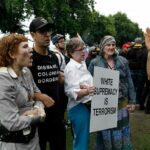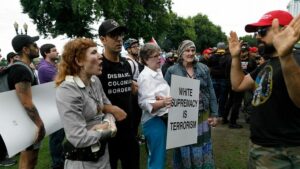Presidential Candidates and Society Debate Protest and Violence

 This article was written for L’Anticapitaliste, the weekly newspaper of the New Anticapitalist Party (NPA) of France.
This article was written for L’Anticapitaliste, the weekly newspaper of the New Anticapitalist Party (NPA) of France.
Protest, sometimes with conflict between anti-racist and rightwing groups, continues in various U.S. cities—Portland, Louisville, and Rochester—over 100 days since the killing of George Floyd. America has not seen such street fighting between ordinary people since the days of the civil rights movement of the 1960s. The anti-racist protests have been driven by continued police killings of black men and women and the failure of mayors, prosecutors, and police chiefs to fire or indict the officers responsible. Armed rightwing counter-protestors have been showing up at demonstrations and three people have been killed in street battles so far.
While the violence is limited to just a few cities it has become the central issue in the presidential election. After the police shot Jacob Blake in Kenosha, President Donald Trump went there to meet with the police, while Democratic Party candidate Joseph Biden met with Blake’s family. Trump claims that if Biden is elected, violence will spread across America and the mostly white suburbs will be destroyed, while Biden supports the protests but condemns violence and advocates reconciliation.
Trump’s appeal to white voters afraid of Black protestors is quite clear. He suggests that Democrats want more public housing, (presumably filled with Black tenants) in the white suburbs. Sales of guns and ammunition, mostly to white buyers, have reached unprecedented levels of hundreds of millions of dollars. At the same time the unofficial armed militia groups are proliferating, growing, and becoming bolder.
By focusing on ”law and order” Trump is trying to turn the campaign away from the disastrous health and economic situations. The United States is approaching 190,000 deaths and the virus is spreading, most recently rising in the plains states. With school, bars, restaurants, and gyms now reopening in many places, epidemiologists fear new outbreaks. It is also expected that winter weather and the flu will contribute to a second wave in the fall.
Meanwhile the economic situation has improved only slightly; there are still about 30 million unemployed and the federal government supplement to state unemployment has fallen from $600 per week to $300. The Centers for Disease Control issued an order preventing landlords from evicting some 30 million people who face eviction for nonpayment of rent, though the process is complicated and renters will still owe back rent. As the election campaigns go on for the next two months the question is will voters reject Trump because of his handling of the virus and the economic crisis or will they embrace him because of his promise to defend them from violence?
The left continues to support and to participate in protest in those few cities where they continue. The far left focuses on the fight against police racism and violence, while more moderate leftists emphasizes the election of Biden—even if they don’t like his politics—and the need to drive Trump from the White House. Some on the far left defend looting, though most emphasize peaceful protest. Socialists have become more active in attempts to organize workers, though our campaigns are still small and marginal to most of the labor movement. Until the election is over, a vaccine is available, the pandemic ends, and the economy revives we will all be waiting for the end of the terrible year 2020 and a return to a more vigorous fight for socialism.